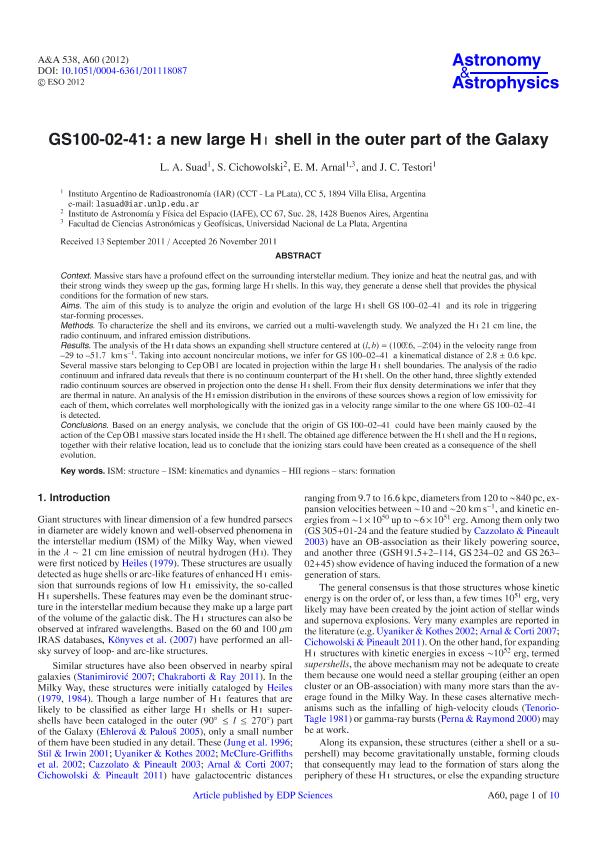Mostrar el registro sencillo del ítem
dc.contributor.author
Suad, Laura Andrea

dc.contributor.author
Cichowolski, Silvina

dc.contributor.author
Arnal, Edmundo Marcelo

dc.contributor.author
Testori, Juan Carlos

dc.date.available
2021-08-19T15:55:03Z
dc.date.issued
2012-02
dc.identifier.citation
Suad, Laura Andrea; Cichowolski, Silvina; Arnal, Edmundo Marcelo; Testori, Juan Carlos; GS100-02-41: a new large H i shell in the outer part of the Galaxy; EDP Sciences; Astronomy and Astrophysics; 538; A60; 2-2012; 60-69
dc.identifier.issn
0004-6361
dc.identifier.uri
http://hdl.handle.net/11336/138531
dc.description.abstract
Context. Massive stars have a profound effect on the surrounding interstellar medium. They ionize and heat the neutral gas, and with their strong winds they sweep up the gas, forming large H i shells. In this way, they generate a dense shell that provides the physical conditions for the formation of new stars. Aims: The aim of this study is to analyze the origin and evolution of the large H i shell GS 100-02-41 and its role in triggering star-forming processes. Methods: To characterize the shell and its environs, we carried out a multi-wavelength study. We analyzed the H i 21 cm line, the radio continuum, and infrared emission distributions. Results: The analysis of the H i data shows an expanding shell structure centered at (l,b) = (100°.6, -2°.04) in the velocity range from -29 to -51.7 km s-1. Taking into account noncircular motions, we infer for GS 100-02-41 a kinematical distance of 2.8 ± 0.6 kpc. Several massive stars belonging to Cep OB1 are located in projection within the large H i shell boundaries. The analysis of the radio continuum and infrared data reveals that there is no continuum counterpart of the H i shell. On the other hand, three slightly extended radio continuum sources are observed in projection onto the dense H i shell. From their flux density determinations we infer that they are thermal in nature. An analysis of the H i emission distribution in the environs of these sources shows a region of low emissivity for each of them, which correlates well morphologically with the ionized gas in a velocity range similar to the one where GS 100-02-41 is detected. Conclusions: Based on an energy analysis, we conclude that the origin of GS 100-02-41 could have been mainly caused by the action of the Cep OB1 massive stars located inside the H i shell. The obtained age difference between the H i shell and the H ii regions, together with their relative location, lead us to conclude that the ionizing stars could have been created as a consequence of the shell evolution.
dc.format
application/pdf
dc.language.iso
eng
dc.publisher
EDP Sciences

dc.rights
info:eu-repo/semantics/openAccess
dc.rights.uri
https://creativecommons.org/licenses/by-nc-sa/2.5/ar/
dc.subject
ISM: structure
dc.subject
ISM: kinematics and dynamics
dc.subject
HII regions
dc.subject
stars: formation
dc.subject.classification
Astronomía

dc.subject.classification
Ciencias Físicas

dc.subject.classification
CIENCIAS NATURALES Y EXACTAS

dc.title
GS100-02-41: a new large H i shell in the outer part of the Galaxy
dc.type
info:eu-repo/semantics/article
dc.type
info:ar-repo/semantics/artículo
dc.type
info:eu-repo/semantics/publishedVersion
dc.date.updated
2021-08-17T15:53:03Z
dc.journal.volume
538
dc.journal.number
A60
dc.journal.pagination
60-69
dc.journal.pais
Francia

dc.journal.ciudad
Paris
dc.description.fil
Fil: Suad, Laura Andrea. Provincia de Buenos Aires. Gobernación. Comisión de Investigaciones Científicas. Instituto Argentino de Radioastronomía. Consejo Nacional de Investigaciones Científicas y Técnicas. Centro Científico Tecnológico Conicet - La Plata. Instituto Argentino de Radioastronomía; Argentina
dc.description.fil
Fil: Cichowolski, Silvina. Provincia de Buenos Aires. Gobernación. Comisión de Investigaciones Científicas. Instituto Argentino de Radioastronomía. Consejo Nacional de Investigaciones Científicas y Técnicas. Centro Científico Tecnológico Conicet - La Plata. Instituto Argentino de Radioastronomía; Argentina
dc.description.fil
Fil: Arnal, Edmundo Marcelo. Provincia de Buenos Aires. Gobernación. Comisión de Investigaciones Científicas. Instituto Argentino de Radioastronomía. Consejo Nacional de Investigaciones Científicas y Técnicas. Centro Científico Tecnológico Conicet - La Plata. Instituto Argentino de Radioastronomía; Argentina
dc.description.fil
Fil: Testori, Juan Carlos. Provincia de Buenos Aires. Gobernación. Comisión de Investigaciones Científicas. Instituto Argentino de Radioastronomía. Consejo Nacional de Investigaciones Científicas y Técnicas. Centro Científico Tecnológico Conicet - La Plata. Instituto Argentino de Radioastronomía; Argentina
dc.journal.title
Astronomy and Astrophysics

dc.relation.alternativeid
info:eu-repo/semantics/altIdentifier/doi/http://dx.doi.org/10.1051/0004-6361/201118087
dc.relation.alternativeid
info:eu-repo/semantics/altIdentifier/url/https://www.aanda.org/articles/aa/full_html/2012/02/aa18087-11/aa18087-11.html
Archivos asociados
